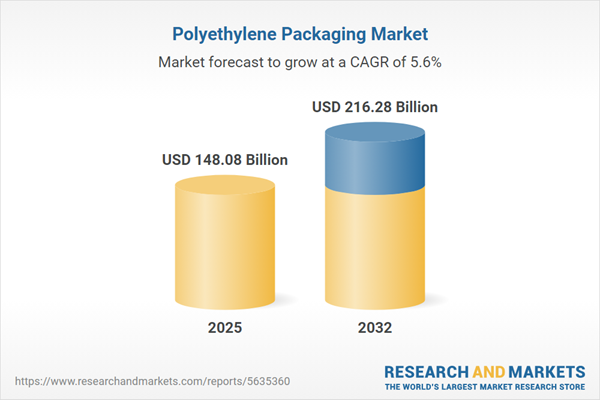Speak directly to the analyst to clarify any post sales queries you may have.
Amid shifting regulatory frameworks, advancing sustainability mandates, and rapid digital transformation, senior executives in the polyethylene packaging market must proactively address new challenges while maintaining operational agility and strong compliance across the value chain.
Market Snapshot: Polyethylene Packaging Market Growth and Outlook
The global polyethylene packaging market is currently valued at USD 140.26 billion, with a compound annual growth rate of 5.56% projected through 2025. Industry forecasts anticipate the market will reach USD 148.08 billion in the near term and continue to climb to USD 216.28 billion by 2032. The market’s expansion is fueled by demand for sustainable packaging solutions, increasing regulatory requirements, and ongoing efforts to enhance supply chain resilience. Stakeholder expectations are driving organizations to operationalize sustainability and compliance, providing companies the ability to meet evolving standards and maintain a strategic edge.
Scope & Segmentation: Key Dimensions in the Polyethylene Packaging Market
- Structure: Both mono-layer and multi-layer polyethylene packaging solutions are utilized across agriculture, healthcare, and food service sectors, enhancing compliance with safety guidelines and optimizing logistics for goods requiring controlled storage or transit conditions.
- Product Form: Bags, sacks, films, sheets, bottles, jars, caps, and closures offer a wide array of packaging formats to address operational nuances in retail, industrial, and niche commercial settings, enabling customized supply and retail chain strategies.
- Thickness: A full spectrum of lightweight and heavy-duty packaging satisfies the need for durability, efficient storage, and cost-effective transportation, supporting adaptive logistics for diverse shipping and warehousing requirements.
- Material Types: High-density (HDPE), medium-density (MDPE), linear low-density (LLDPE), and low-density (LDPE) polyethylene grades empower organizations to tailor packaging attributes for clarity, flexibility, or compliance, aligning with both market and regulatory shifts.
- End Use Industry: Sectors such as agriculture, food and beverage, healthcare, automotive, and electronics adopt polyethylene packaging for shelf-life extension, improved product traceability, and alignment with rigorous industry standards.
- Geography: Regional market dynamics in the Americas, Europe, Middle East, Africa, and Asia-Pacific require firms to customize packaging solutions for local recycling guidelines, infrastructure readiness, and compliance environments.
- Prominent Companies: Companies including China Petroleum & Chemical Corporation, Saudi Basic Industries Corporation, Dow Inc., LyondellBasell Industries N.V., INEOS Group Limited, Braskem S.A., Formosa Plastics Corporation, Exxon Mobil Corporation, Borealis AG, and TotalEnergies SE drive innovation and strengthen global supply chain integration with new product development and operational advances.
Key Takeaways: Strategic Insights for Decision-Makers
- Integrating recyclable and bio-based packaging is increasingly important for sustainability, supporting compliance as regulatory oversight expands in key markets.
- Strong partnerships with logistics and waste management providers contribute to end-to-end resource stewardship and comprehensive end-of-life packaging solutions.
- Implementation of digital printing and smart packaging tools helps companies meet traceability and labeling requirements, particularly for sectors where regulatory and product integrity are critical.
- Manufacturers investing in advanced extrusion, compounding, and recycling systems position their operations to flexibly respond to new policy directions and customer preferences.
- Regional customization of design and distribution networks strengthens relationships with international customers and enables rapid compliance with country-specific mandates.
Tariff Impact: Effects of U.S. 2025 Trade Measures
With new U.S. tariff measures, packaging providers are reassessing their sourcing strategies and increasing collaboration with domestic resin suppliers. This environment is resulting in more joint ventures and greater supply security, equipping companies to adjust rapidly to North American trade policy adjustments and minimize exposure to global market fluctuations.
Methodology & Data Sources
This report combines executive perspectives from resin production, packaging design, and waste management specialists with data from leading trade publications and peer-reviewed studies. The analysis is structured to deliver decision-ready intelligence directly supporting strategic action in the polyethylene packaging sector.
Why This Report Matters
- Offers senior decision-makers actionable frameworks for implementing technology, responding to new compliance directives, and increasing resilience in global and regional operations.
- Supports scenario planning to anticipate tariff impacts, accelerate sustainability initiatives, and ensure alignment with ESG priorities for long-term value creation.
- Highlights key trends and segment insights that streamline procurement, guide resource allocation, and inform product development strategies.
Conclusion
This analysis equips industry leaders with the critical guidance needed to strengthen risk controls, drive innovation, and align operations with sustainable and robust practices for ongoing success in the polyethylene packaging industry.
Additional Product Information:
- Purchase of this report includes 1 year online access with quarterly updates.
- This report can be updated on request. Please contact our Customer Experience team using the Ask a Question widget on our website.
Table of Contents
3. Executive Summary
4. Market Overview
7. Cumulative Impact of Artificial Intelligence 2025
Companies Mentioned
The companies profiled in this Polyethylene Packaging market report include:- China Petroleum & Chemical Corporation
- Saudi Basic Industries Corporation
- Dow Inc.
- LyondellBasell Industries N.V.
- INEOS Group Limited
- Braskem S.A.
- Formosa Plastics Corporation
- Exxon Mobil Corporation
- Borealis AG
- TotalEnergies SE
Table Information
| Report Attribute | Details |
|---|---|
| No. of Pages | 189 |
| Published | November 2025 |
| Forecast Period | 2025 - 2032 |
| Estimated Market Value ( USD | $ 148.08 Billion |
| Forecasted Market Value ( USD | $ 216.28 Billion |
| Compound Annual Growth Rate | 5.5% |
| Regions Covered | Global |
| No. of Companies Mentioned | 11 |









